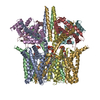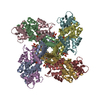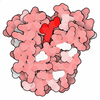+ Open data
Open data
- Basic information
Basic information
| Entry |  | |||||||||
|---|---|---|---|---|---|---|---|---|---|---|
| Title | human KCNQ5-CaM in apo state | |||||||||
 Map data Map data | ||||||||||
 Sample Sample |
| |||||||||
 Keywords Keywords | voltage-gated potassium channel / MEMBRANE PROTEIN | |||||||||
| Function / homology |  Function and homology information Function and homology informationclathrin coat / voltage-gated monoatomic ion channel activity involved in regulation of presynaptic membrane potential / Voltage gated Potassium channels / CaM pathway / Cam-PDE 1 activation / Sodium/Calcium exchangers / Calmodulin induced events / Reduction of cytosolic Ca++ levels / Activation of Ca-permeable Kainate Receptor / CREB1 phosphorylation through the activation of CaMKII/CaMKK/CaMKIV cascasde ...clathrin coat / voltage-gated monoatomic ion channel activity involved in regulation of presynaptic membrane potential / Voltage gated Potassium channels / CaM pathway / Cam-PDE 1 activation / Sodium/Calcium exchangers / Calmodulin induced events / Reduction of cytosolic Ca++ levels / Activation of Ca-permeable Kainate Receptor / CREB1 phosphorylation through the activation of CaMKII/CaMKK/CaMKIV cascasde / Loss of phosphorylation of MECP2 at T308 / CREB1 phosphorylation through the activation of Adenylate Cyclase / CaMK IV-mediated phosphorylation of CREB / PKA activation / negative regulation of high voltage-gated calcium channel activity / Glycogen breakdown (glycogenolysis) / CLEC7A (Dectin-1) induces NFAT activation / Activation of RAC1 downstream of NMDARs / negative regulation of ryanodine-sensitive calcium-release channel activity / organelle localization by membrane tethering / mitochondrion-endoplasmic reticulum membrane tethering / autophagosome membrane docking / negative regulation of calcium ion export across plasma membrane / regulation of cardiac muscle cell action potential / presynaptic endocytosis / Synthesis of IP3 and IP4 in the cytosol / regulation of cell communication by electrical coupling involved in cardiac conduction / Phase 0 - rapid depolarisation / calcineurin-mediated signaling / Negative regulation of NMDA receptor-mediated neuronal transmission / Unblocking of NMDA receptors, glutamate binding and activation / RHO GTPases activate PAKs / Ion transport by P-type ATPases / Uptake and function of anthrax toxins / regulation of ryanodine-sensitive calcium-release channel activity / Long-term potentiation / protein phosphatase activator activity / Calcineurin activates NFAT / Regulation of MECP2 expression and activity / DARPP-32 events / Smooth Muscle Contraction / voltage-gated potassium channel activity / detection of calcium ion / catalytic complex / regulation of cardiac muscle contraction / RHO GTPases activate IQGAPs / regulation of cardiac muscle contraction by regulation of the release of sequestered calcium ion / cellular response to interferon-beta / Protein methylation / calcium channel inhibitor activity / Activation of AMPK downstream of NMDARs / presynaptic cytosol / regulation of release of sequestered calcium ion into cytosol by sarcoplasmic reticulum / Ion homeostasis / eNOS activation / titin binding / Tetrahydrobiopterin (BH4) synthesis, recycling, salvage and regulation / sperm midpiece / regulation of calcium-mediated signaling / voltage-gated potassium channel complex / potassium ion transmembrane transport / calcium channel complex / FCERI mediated Ca+2 mobilization / substantia nigra development / regulation of heart rate / Ras activation upon Ca2+ influx through NMDA receptor / FCGR3A-mediated IL10 synthesis / Antigen activates B Cell Receptor (BCR) leading to generation of second messengers / calyx of Held / adenylate cyclase activator activity / sarcomere / VEGFR2 mediated cell proliferation / protein serine/threonine kinase activator activity / VEGFR2 mediated vascular permeability / regulation of cytokinesis / spindle microtubule / calcium channel regulator activity / Translocation of SLC2A4 (GLUT4) to the plasma membrane / positive regulation of receptor signaling pathway via JAK-STAT / RAF activation / Transcriptional activation of mitochondrial biogenesis / response to calcium ion / cellular response to type II interferon / Stimuli-sensing channels / G2/M transition of mitotic cell cycle / long-term synaptic potentiation / spindle pole / RAS processing / calcium-dependent protein binding / Signaling by RAF1 mutants / Signaling by moderate kinase activity BRAF mutants / Paradoxical activation of RAF signaling by kinase inactive BRAF / Signaling downstream of RAS mutants / Signaling by BRAF and RAF1 fusions / Platelet degranulation / Inactivation, recovery and regulation of the phototransduction cascade / myelin sheath / presynaptic membrane / RAF/MAP kinase cascade / Ca2+ pathway Similarity search - Function | |||||||||
| Biological species |  Homo sapiens (human) Homo sapiens (human) | |||||||||
| Method | single particle reconstruction / cryo EM / Resolution: 2.4 Å | |||||||||
 Authors Authors | Yang Z / Guo J | |||||||||
| Funding support |  China, 1 items China, 1 items
| |||||||||
 Citation Citation |  Journal: Proc Natl Acad Sci U S A / Year: 2025 Journal: Proc Natl Acad Sci U S A / Year: 2025Title: Phosphatidylinositol 4,5-bisphosphate activation mechanism of human KCNQ5. Authors: Zhenni Yang / Yueming Zheng / Demin Ma / Long Wang / Jiatong Zhang / Tiefeng Song / Yong Wang / Yan Zhang / Fajun Nan / Nannan Su / Zhaobing Gao / Jiangtao Guo /  Abstract: The human voltage-gated potassium channels KCNQ2, KCNQ3, and KCNQ5 can form homo- and heterotetrameric channels that are responsible for generating the neuronal M current and maintaining the membrane ...The human voltage-gated potassium channels KCNQ2, KCNQ3, and KCNQ5 can form homo- and heterotetrameric channels that are responsible for generating the neuronal M current and maintaining the membrane potential stable. Activation of KCNQ channels requires both the depolarization of membrane potential and phosphatidylinositol 4,5-bisphosphate (PIP). Here, we report cryoelectron microscopy structures of the human KCNQ5-calmodulin (CaM) complex in the apo, PIP-bound, and both PIP- and the activator HN37-bound states in either a closed or an open conformation. In the closed conformation, a PIP molecule binds in the middle of the groove between two adjacent voltage-sensing domains (VSDs), whereas in the open conformation, one additional PIP binds to the interface of VSD and the pore domain, accompanying structural rearrangement of the cytosolic domain of KCNQ and CaM. The structures, along with electrophysiology analyses, reveal the two different binding modes of PIP and elucidate the PIP activation mechanism of KCNQ5. | |||||||||
| History |
|
- Structure visualization
Structure visualization
| Supplemental images |
|---|
- Downloads & links
Downloads & links
-EMDB archive
| Map data |  emd_61109.map.gz emd_61109.map.gz | 46.5 MB |  EMDB map data format EMDB map data format | |
|---|---|---|---|---|
| Header (meta data) |  emd-61109-v30.xml emd-61109-v30.xml emd-61109.xml emd-61109.xml | 18 KB 18 KB | Display Display |  EMDB header EMDB header |
| Images |  emd_61109.png emd_61109.png | 72.6 KB | ||
| Filedesc metadata |  emd-61109.cif.gz emd-61109.cif.gz | 6 KB | ||
| Others |  emd_61109_half_map_1.map.gz emd_61109_half_map_1.map.gz emd_61109_half_map_2.map.gz emd_61109_half_map_2.map.gz | 44.7 MB 44.7 MB | ||
| Archive directory |  http://ftp.pdbj.org/pub/emdb/structures/EMD-61109 http://ftp.pdbj.org/pub/emdb/structures/EMD-61109 ftp://ftp.pdbj.org/pub/emdb/structures/EMD-61109 ftp://ftp.pdbj.org/pub/emdb/structures/EMD-61109 | HTTPS FTP |
-Validation report
| Summary document |  emd_61109_validation.pdf.gz emd_61109_validation.pdf.gz | 780 KB | Display |  EMDB validaton report EMDB validaton report |
|---|---|---|---|---|
| Full document |  emd_61109_full_validation.pdf.gz emd_61109_full_validation.pdf.gz | 779.6 KB | Display | |
| Data in XML |  emd_61109_validation.xml.gz emd_61109_validation.xml.gz | 11.5 KB | Display | |
| Data in CIF |  emd_61109_validation.cif.gz emd_61109_validation.cif.gz | 13.5 KB | Display | |
| Arichive directory |  https://ftp.pdbj.org/pub/emdb/validation_reports/EMD-61109 https://ftp.pdbj.org/pub/emdb/validation_reports/EMD-61109 ftp://ftp.pdbj.org/pub/emdb/validation_reports/EMD-61109 ftp://ftp.pdbj.org/pub/emdb/validation_reports/EMD-61109 | HTTPS FTP |
-Related structure data
| Related structure data |  9j38MC  9lizC  9lj1C  9lj5C M: atomic model generated by this map C: citing same article ( |
|---|---|
| Similar structure data | Similarity search - Function & homology  F&H Search F&H Search |
- Links
Links
| EMDB pages |  EMDB (EBI/PDBe) / EMDB (EBI/PDBe) /  EMDataResource EMDataResource |
|---|---|
| Related items in Molecule of the Month |
- Map
Map
| File |  Download / File: emd_61109.map.gz / Format: CCP4 / Size: 52.7 MB / Type: IMAGE STORED AS FLOATING POINT NUMBER (4 BYTES) Download / File: emd_61109.map.gz / Format: CCP4 / Size: 52.7 MB / Type: IMAGE STORED AS FLOATING POINT NUMBER (4 BYTES) | ||||||||||||||||||||||||||||||||||||
|---|---|---|---|---|---|---|---|---|---|---|---|---|---|---|---|---|---|---|---|---|---|---|---|---|---|---|---|---|---|---|---|---|---|---|---|---|---|
| Projections & slices | Image control
Images are generated by Spider. | ||||||||||||||||||||||||||||||||||||
| Voxel size | X=Y=Z: 0.93 Å | ||||||||||||||||||||||||||||||||||||
| Density |
| ||||||||||||||||||||||||||||||||||||
| Symmetry | Space group: 1 | ||||||||||||||||||||||||||||||||||||
| Details | EMDB XML:
|
-Supplemental data
-Half map: #1
| File | emd_61109_half_map_1.map | ||||||||||||
|---|---|---|---|---|---|---|---|---|---|---|---|---|---|
| Projections & Slices |
| ||||||||||||
| Density Histograms |
-Half map: #2
| File | emd_61109_half_map_2.map | ||||||||||||
|---|---|---|---|---|---|---|---|---|---|---|---|---|---|
| Projections & Slices |
| ||||||||||||
| Density Histograms |
- Sample components
Sample components
-Entire : human KCNQ5-CaM in apo state
| Entire | Name: human KCNQ5-CaM in apo state |
|---|---|
| Components |
|
-Supramolecule #1: human KCNQ5-CaM in apo state
| Supramolecule | Name: human KCNQ5-CaM in apo state / type: complex / ID: 1 / Parent: 0 / Macromolecule list: all |
|---|---|
| Source (natural) | Organism:  Homo sapiens (human) Homo sapiens (human) |
-Macromolecule #1: Potassium voltage-gated channel subfamily KQT member 5
| Macromolecule | Name: Potassium voltage-gated channel subfamily KQT member 5 type: protein_or_peptide / ID: 1 / Number of copies: 4 / Enantiomer: LEVO |
|---|---|
| Source (natural) | Organism:  Homo sapiens (human) Homo sapiens (human) |
| Molecular weight | Theoretical: 68.776484 KDa |
| Recombinant expression | Organism:  Homo sapiens (human) Homo sapiens (human) |
| Sequence | String: MLGKPLSYTS SQSCRRNVKY RRVQNYLYNV LERPRGWAFI YHAFVFLLVF GCLILSVFST IPEHTKLASS CLLILEFVMI VVFGLEFII RIWSAGCCCR YRGWQGRLRF ARKPFCVIDT IVLIASIAVV SAKTQGNIFA TSALRSLRFL QILRMVRMDR R GGTWKLLG ...String: MLGKPLSYTS SQSCRRNVKY RRVQNYLYNV LERPRGWAFI YHAFVFLLVF GCLILSVFST IPEHTKLASS CLLILEFVMI VVFGLEFII RIWSAGCCCR YRGWQGRLRF ARKPFCVIDT IVLIASIAVV SAKTQGNIFA TSALRSLRFL QILRMVRMDR R GGTWKLLG SVVYAHSKEL ITAWYIGFLV LIFSSFLVYL VEKDANKEFS TYADALWWGT ITLTTIGYGD KTPLTWLGRL LS AGFALLG ISFFALPAGI LGSGFALKVQ EQHRQKHFEK RRNPAANLIQ CVWRSYAADE KSVSIATWKP HLKALHTCSP TKK EQGEAS SSQKLSFKER VRMASPRGQS IKSRQASVGD RRSPSTDITA EGSPTKVQKS WSFNDRTRFR PSLRLKSSQP KPVI DADTA LGTDDVYDEK GCQCDVSVED LTPPLKTVIR AIRIMKFHVA KRKFKETLRP YDVKDVIEQY SAGHLDMLCR IKSLQ TRVD QILGKGQITS DKKSREKITA EHETTDDLSM LGRVVKVEKQ VQSIESKLDC LLDIYQQVLR KGSASALALA SFQIPP FEC EQTSDYQSPV DSKDLSGSAQ NSGCLSRSTS ANISRGLQFI LTPNEFS UniProtKB: Potassium voltage-gated channel subfamily KQT member 5 |
-Macromolecule #2: Calmodulin-1
| Macromolecule | Name: Calmodulin-1 / type: protein_or_peptide / ID: 2 / Number of copies: 4 / Enantiomer: LEVO |
|---|---|
| Source (natural) | Organism:  Homo sapiens (human) Homo sapiens (human) |
| Molecular weight | Theoretical: 16.852545 KDa |
| Recombinant expression | Organism:  Homo sapiens (human) Homo sapiens (human) |
| Sequence | String: MADQLTEEQI AEFKEAFSLF DKDGDGTITT KELGTVMRSL GQNPTEAELQ DMINEVDADG NGTIDFPEFL TMMARKMKDT DSEEEIREA FRVFDKDGNG YISAAELRHV MTNLGEKLTD EEVDEMIREA DIDGDGQVNY EEFVQMMTAK UniProtKB: Calmodulin-1 |
-Experimental details
-Structure determination
| Method | cryo EM |
|---|---|
 Processing Processing | single particle reconstruction |
| Aggregation state | particle |
- Sample preparation
Sample preparation
| Buffer | pH: 8 |
|---|---|
| Vitrification | Cryogen name: ETHANE |
- Electron microscopy
Electron microscopy
| Microscope | FEI TITAN KRIOS |
|---|---|
| Image recording | Film or detector model: GATAN K2 QUANTUM (4k x 4k) / Average electron dose: 52.0 e/Å2 |
| Electron beam | Acceleration voltage: 300 kV / Electron source:  FIELD EMISSION GUN FIELD EMISSION GUN |
| Electron optics | Illumination mode: FLOOD BEAM / Imaging mode: BRIGHT FIELD / Cs: 2.7 mm / Nominal defocus max: 1.6 µm / Nominal defocus min: 0.8 µm |
| Experimental equipment |  Model: Titan Krios / Image courtesy: FEI Company |
 Movie
Movie Controller
Controller




























 Z (Sec.)
Z (Sec.) Y (Row.)
Y (Row.) X (Col.)
X (Col.)




































